Cellular Digital Packet Data (CDPD) is an obsolete wide-area mobile data service which used unused bandwidth normally used by Advanced Mobile Phone System (AMPS) mobile phones between 800 and 900 MHz to transfer data. Speeds up to 19.2 kbit/s were possible, though real world speeds seldom reached higher than 9.6 kbit/s. The service was discontinued in conjunction with the retirement of the parent AMPS service; it has been functionally replaced by faster services such as 1xRTT, Evolution-Data Optimized, and UMTS/High Speed Packet Access (HSPA).

IEEE 802 is a family of Institute of Electrical and Electronics Engineers (IEEE) standards for local area networks (LANs), personal area networks (PANs), and metropolitan area networks (MANs). The IEEE 802 LAN/MAN Standards Committee (LMSC) maintains these standards. The IEEE 802 family of standards has had twenty-four members, numbered 802.1 through 802.24, with a working group of the LMSC devoted to each. However, not all of these working groups are currently active.

A personal digital assistant (PDA), also known as a handheld PC, is a multi-purpose mobile device which functions as a personal information manager. PDAs have been mostly displaced by the widespread adoption of highly capable smartphones, in particular those based on iOS and Android, and thus saw a rapid decline in use after 2007.

A wireless LAN (WLAN) is a wireless computer network that links two or more devices using wireless communication to form a local area network (LAN) within a limited area such as a home, school, computer laboratory, campus, or office building. This gives users the ability to move around within the area and remain connected to the network. Through a gateway, a WLAN can also provide a connection to the wider Internet.

3Com Corporation was an American digital electronics manufacturer best known for its computer network products. The company was co-founded in 1979 by Robert Metcalfe, Howard Charney and others. Bill Krause joined as President in 1981. Metcalfe explained the name 3Com was a contraction of "Computer Communication Compatibility", with its focus on Ethernet technology that he had co-invented, which enabled the networking of computers.

Wireless communication is the transfer of information (telecommunication) between two or more points without the use of an electrical conductor, optical fiber or other continuous guided medium for the transfer. The most common wireless technologies use radio waves. With radio waves, intended distances can be short, such as a few meters for Bluetooth or as far as millions of kilometers for deep-space radio communications. It encompasses various types of fixed, mobile, and portable applications, including two-way radios, cellular telephones, personal digital assistants (PDAs), and wireless networking. Other examples of applications of radio wireless technology include GPS units, garage door openers, wireless computer mouse, keyboards and headsets, headphones, radio receivers, satellite television, broadcast television and cordless telephones. Somewhat less common methods of achieving wireless communications involve other electromagnetic phenomena, such as light and magnetic or electric fields, or the use of sound.
Mobitex is an OSI based open standard, national public access wireless packet-switched data network. Mobitex puts great emphasis on safety and reliability with its use by military, police, firefighters and ambulance services. It was developed in the beginning of the 1980s by the Swedish Televerket Radio. From 1988, the development took place in Eritel, a joint-venture between Ericsson and Televerket, later on as an Ericsson subsidiary. Mobitex became operational in Sweden in 1986.
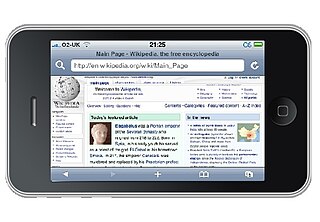
A mobile browser is a web browser designed for use on a mobile device such as a mobile phone, PDA, smartphone, or tablet. Mobile browsers are optimized to display web content most effectively on small screens on portable devices. Some mobile browsers, especially older versions, are designed to be small and efficient to accommodate the low memory capacity and low bandwidth of certain wireless handheld devices. Traditional smaller feature phones use stripped-down mobile web browsers; however, most current smartphones have full-fledged browsers that can handle the latest web technologies, such as CSS 3, JavaScript, and Ajax.
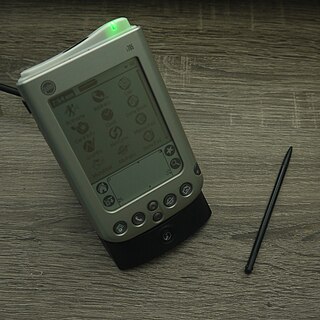
The Palm i705 was an upgrade from the last series of Palm PDAs to use the now discontinued Palm.net service via Mobitex to access the World Wide Web from Palm devices. It featured 8MB of onboard memory and an SD/MMC slot for additional storage or SDIO cards. It used the Motorola Dragonball VZ 33 MHz processor and ran Palm OS 4.1, it was noted as being the first Palm.net capable device without a flip out antenna and with an internal rechargeable battery, although it was the third and final of the three models manufactured by Palm that were capable of utilizing this network.
Push email is an email system that provides an always-on capability, in which when new email arrives at the mail delivery agent (MDA), it is immediately, actively transferred (pushed) by the MDA to the mail user agent (MUA), also called the email client, so that the end-user can see incoming email immediately. This is in contrast with systems that check for new incoming mail every so often, on a schedule. Email clients include smartphones and, less strictly, IMAP personal computer mail applications.

A computer network is a set of computers sharing resources located on or provided by network nodes. Computers use common communication protocols over digital interconnections to communicate with each other. These interconnections are made up of telecommunication network technologies based on physically wired, optical, and wireless radio-frequency methods that may be arranged in a variety of network topologies.
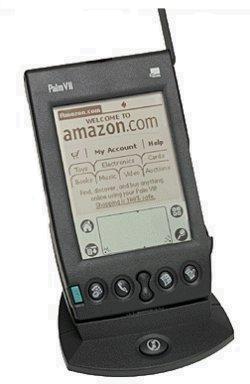
The Palm VII was a personal digital assistant made by the Palm Computing division of 3Com. The device featured an antenna used for wireless data communication, a first for a Palm device. Connectivity was provided through the Mobitex network, under the now defunct Palm.net service. Web Clipping applications, also known as Palm Query Applications (PQAs) made use of the network to request and post web data. The devices also provided PQA developers with the user's position, in the form of a zipcode, making the Palm VII the first web-enabled Location-Based Services mobile platform. The cost of service was $14.95 per month, and allowed a limited number of web pages to be viewed.
Wireless Application Protocol (WAP) is a technical standard for accessing information over a mobile wireless network. A WAP browser is a web browser for mobile devices such as mobile phones that use the protocol. Introduced in 1999, WAP achieved some popularity in the early 2000s, but by the 2010s it had been largely superseded by more modern standards such as XHTML. Modern phones have proper Web browsers, so they do not need WAP markup for compatibility, and therefore, most are no longer able to render and display pages written in WML, WAP's markup language.
Windows Rally is a set of technologies from Microsoft intended to simplify the setup and maintenance of wired and wireless network-connected devices. They aim to increase reliability and security of connectivity for users who connect the devices to the Internet or to computers running Microsoft Windows. These technologies provide control of network quality of service (QoS) and diagnostics for data sharing, communications, and entertainment. Windows Rally technologies provide provisioning for the following devices:

The Palm Centro is a smartphone marketed by Palm, Inc. beginning its release on October 14, 2007, offering the functionality of the larger Treo 755p in a smaller size.

The BlackBerry Storm is a touchscreen smartphone developed by Research In Motion. A part of the BlackBerry 9500 series of phones, it was RIM's first touchscreen device, and its first without a physical keyboard. It featured a touchscreen that responded like a button via SurePress, Research In Motion's haptic feedback technology. Its competitors included Apple's iPhone, the Palm Pre, the T-Mobile G1 by HTC and the HTC Touch family.
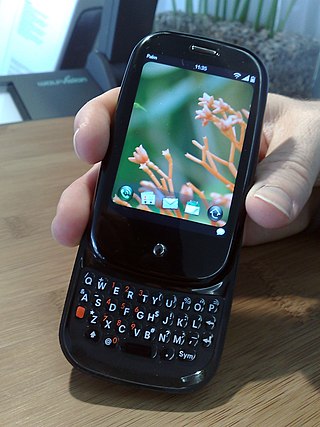
The Palm Pre, styled as palm prē, is a multitasking smartphone that was designed and marketed by Palm with a multi-touch screen and a sliding keyboard. The smartphone was the first to use Palm's Linux-based mobile operating system, webOS. The Pre functions as a camera phone and a portable media player, and has location and navigation capabilities. The Pre also serves as a personal information manager, has a number of communication and collaboration applications, and has Bluetooth and Wi-Fi connectivity built-in.
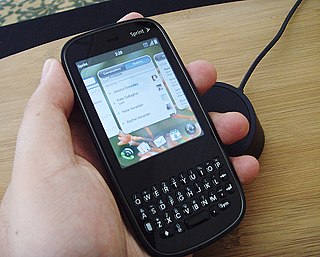
The Palm Pixi and Pixi Plus are multimedia smartphones, developed by Palm, which was purchased in 2010 by HP. The device is viewed as a successor to the Palm Centro smartphone and was Palm's second webOS device, after the Palm Pre.
Palm.net was a wireless data communication service enabling limited wireless access of the World Wide Web, provided for certain Palm, Inc. Personal Digital Assistants. Connectivity was provided through the Mobitex network. Web Clipping applications made use of the network to process data. The cost of service was $14.95 per month, and allowed a limited number of web pages to be viewed. The initial Palm model to be capable of using the service was the Palm VII, which made it the first standalone PDA to be capable of wireless internet access. Later models included the Palm VIIx and Palm i705. The service started in 1999 and was discontinued on August 31, 2004.

Mobile technology is the technology used for cellular communication. Mobile technology has evolved rapidly over the past few years. Since the start of this millennium, a standard mobile device has gone from being no more than a simple two-way pager to being a mobile phone, GPS navigation device, an embedded web browser and instant messaging client, and a handheld gaming console. Many experts believe that the future of computer technology rests in mobile computing with wireless networking. Mobile computing by way of tablet computers is becoming more popular. Tablets are available on the 3G and 4G networks.














